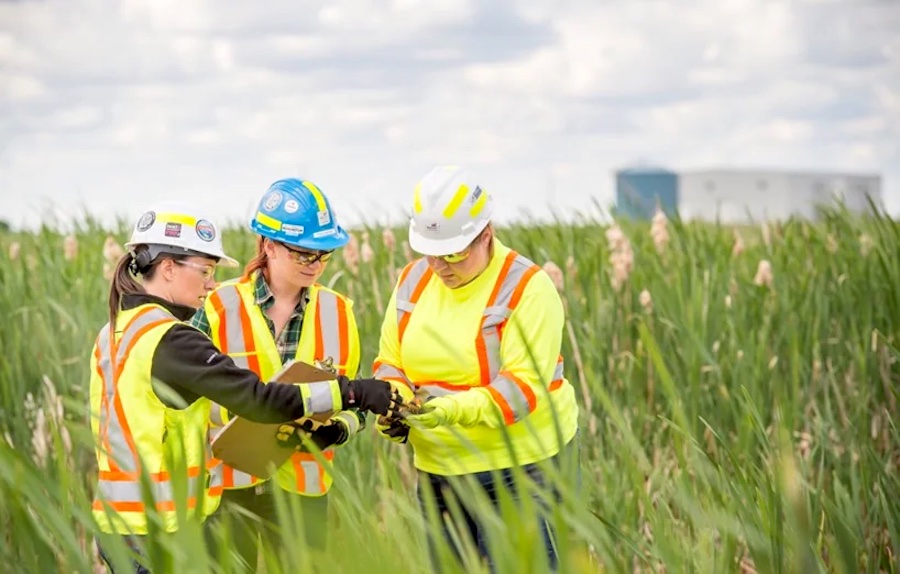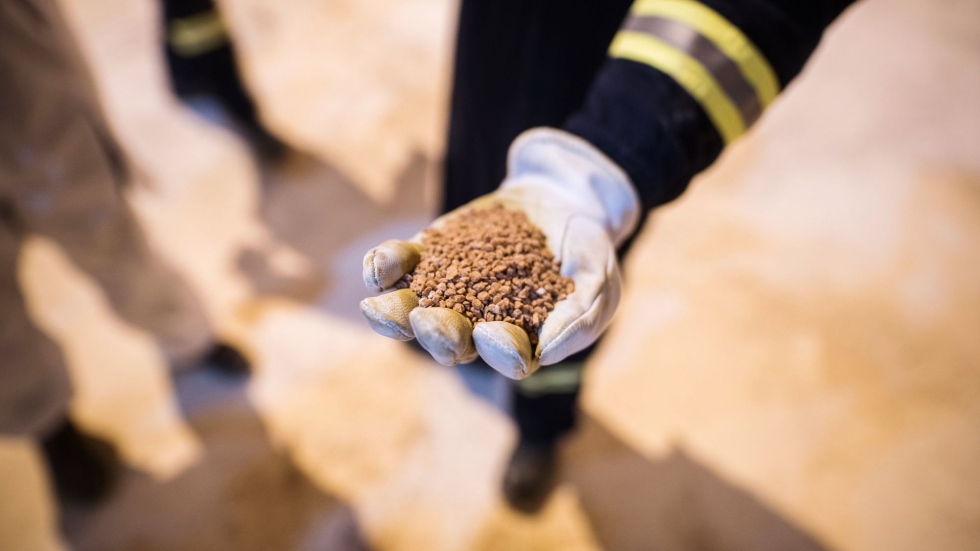WHATEVER HAPPENED TO; 'POLLUTER PAYES'
Canadian government pledges up to $100M to help reduce emissions at future BHP potash mine in Sask.
Feds offer funding for BHP Jansen mine
The Canadian government has offered up to $100 million to help global Australian mining giant BHP create the "world's most sustainable potash mine" in rural Saskatchewan.
BHP's Jansen mine project, located about 140 kilometres east of Saskatoon, is currently in development and is expected to be operational by 2027. It's planned to be the largest potash producing mine in the world,.
Canadian officials are putting the money forward to help the company reduce the mine's carbon footprint and invest in more environmentally friendly technology.
The company said it is committed to reducing emissions.
"You will see 50 per cent less carbon dioxide coming out of this mine than a traditional potash mine. We're committed to responsible use of water, we will use 60 per cent less water than your average mine in terms of production of potash on a tonne-per-tonne basis," Ragnar Udd, president for minerals America with BHP, said while speaking at the federal funding announcement in Saskatoon on Monday morning.
"We expect that Jansen will generate the lowest direct onsite emissions intensity of any potash mine in North America."
Udd said BHP expects to use 60 per cent less equipment underground for the Jansen mine, while being 2.5 times more productive.
It will also introduce electric vehicles for underground work, reducing diesel exhaust. Funding will help the mine be more technically advanced, embracing "state of the art" integrated mining systems for boring and bringing the minerals to the surface, Udd said.
Potash is a potassium-rich salt used mainly as fertilizer by farmers.
Federal officials said on Monday that the partnership between the government and BHP is expected to benefit the environment and the economy, while addressing growing global food security concerns and shortages.
Mike Henry, BHP's CEO, noted Russia's invasion of Ukraine has disrupted the global potash supply and emphasized the need for a more stable provider.
Both Russia and Ukraine are major fertilizer-producing countries. Henry said Canada is seen as a stable jurisdiction that can meet the growing global demand for years to come.
"We think the need for potash is going to be driven by global population growth, the move to improve diets, and the need for more sustainable agriculture," he said.
BHP committed to the Jansen Stage 1 project last year with a $7.5-billion investment — a decision Henry said was a decade in the making. He said the company's commitment to potash mining in Canada is a vote of confidence for the country.
The company anticipates its initial production capacity will be 4.3 to 4.5 million tonnes of potash per year, increasing Canada's production of the mineral by nearly 22 per cent.
Federal Industry Minister François-Philippe Champagne said Canada exported 22 million tonnes of potash last year, and like Henry, he believes the demand will only grow.
In addition to its green ambitions, officials note that the project is expected to create hundreds of local jobs. BHP has also signed opportunities agreements with six First Nations in southern Saskatchewan in an effort to further economic opportunity and partnership.
Henry said BHP is accelerating the work on Phase One and launching studies for Phase Two.
BHP open to potash partner, but plans to
enter fertilizer business alone
UNTRUE CANADIAN TAXPAYERS ARE YOUR PARTNERS
Reuters | June 13, 2022 |

BHP to start potash production at Jansen a year earlier than planned.
(Image courtesy of BHP.)

“We are more than happy and willing to work with partners. We don’t need a partner though,” Ragnar Udd, BHP president of Minerals Americas, said in an interview with Reuters. “So it has to be really about what’s that partner actually going to be contributing to the mix.”
BHP last month said it was looking at accelerating the Jansen, Saskatchewan project by a year amid tight global potash supplies after Russia’s invasion of Ukraine. Prices of the crop nutrient have soared since Western sanctions were imposed against Russia over the invasion.
Nutrien, the world’s biggest potash producer and based in Saskatchewan, last week said it plans to boost capacity by 20% by 2025.
Nutrien interim CEO Ken Seitz told Reuters that he has had no discussions with BHP since taking that job in January.
Russia and Belarus, which also faces sanctions, are the world’s second- and third-largest potash producers, while Canada is No. 1.
Prior to the sanctions, some analysts said potash output looked well-supplied. But Udd said steady global demand growth for potash appeals to BHP, and planned expansions of eastern European mines now look to be in jeopardy.
Jansen’s first phase is estimated to cost up to $5.7 billion with annual capacity to produce 4.4 million tonnes, starting as soon as late 2026.
“Are we contributing to a glut? That remains to be seen,” Udd said, adding that BHP eventually wants to be the market leader.
Jansen’s mine shafts are designed for capacity of 16 million tonnes annually, Udd said.
Canada will invest up to C$100 million ($77.83 million) in Jansen’s development as a low-emissions mine, Canadian Industry Minister Francois-Philippe Champagne said earlier on Monday.
“We know how critical potash is for our country when it comes to food security,” Champagne said.
BHP, in a partnership with Sandvik AB, is planning to install new mining systems at the mine that are expected to reduce environmental impact by using 60% less equipment underground than traditional potash mines, Udd said.
Reuters, citing a source, has reported that the investment will allow BHP to use electric vehicles and equipment.
($1 = 1.2844 Canadian dollars)
(By Ismail Shakil; Editing by Chris Reese, Will Dunham and Mark Porter)


Jansen could start potash production in late 2026: BHP executive Ragnar Udd

The potential of potash
Pat McKay
Multi-Skilled Journalist
Updated June 13, 2022
The Government of Canada and mining giant BHP have committed to making the potash mine outside Jansen, Sask. the world’s largest and greenest.
“We want to be the green supplier of choice to the world,” Minister of Innovation, Science and Industry François-Philippe Champagne said.
The federal government will spend $100 million on what it calls state-of-the-art mining systems. The Jansen project is estimated to cost up to $5.7 billion in the first phase, which is expected to take five years and have an annual capacity to produce around 4.4 million tonnes of potash.
The federal deal covers a $400 million component of that project, said Ragnar Udd, president of BHP's Minerals Americas division.
“We're committed to the responsible use of water. We will use 60 per cent less water than your average mine, in terms of production of potash on a ton-per-ton basis, and we expect that Jansen will generate the lowest direct on-site emissions intensity of any potash mine in North America.”
Udd says 3,500 jobs will be created at peak construction, while 600 employees will work at the mine long-term.
“We will have a gender-balanced workforce from day one, and 20 per cent of our workforce will be an Indigenous workforce, as well partnering with our local Indigenous groups and tribes that actually work closely together.”
Champagne says the future is bright when it comes to greening the supply chain in Canada.
“We've been transforming the steel industry to produce green steel which we're going to be one of the first producers in the world,” he said. “We're going to be the first producer of green aluminum, we're looking at green batteries, now we're going to be producing green potash.”
“My message when I was at the Economic Forum in Europe, and when I'm going to be in Japan and Korea later on this month, is that we can be part of the solution. We could be the green supplier of choice for the number of critical minerals you need, and parts and equipment.”
BHP says as the world population continues to grow, growing crops with less arable soil through improved agricultural practices and fertilizers will be a must.
“If you're a world agricultural producer going forward and looking at options around secure supply chains, Canada's going to be front and centre,” said BHP CEO Mike Henry.
- With Reuters files
RELATED STORIES

Pieces of potash at a surplus pile at the Mosaic potash mine in

No comments:
Post a Comment